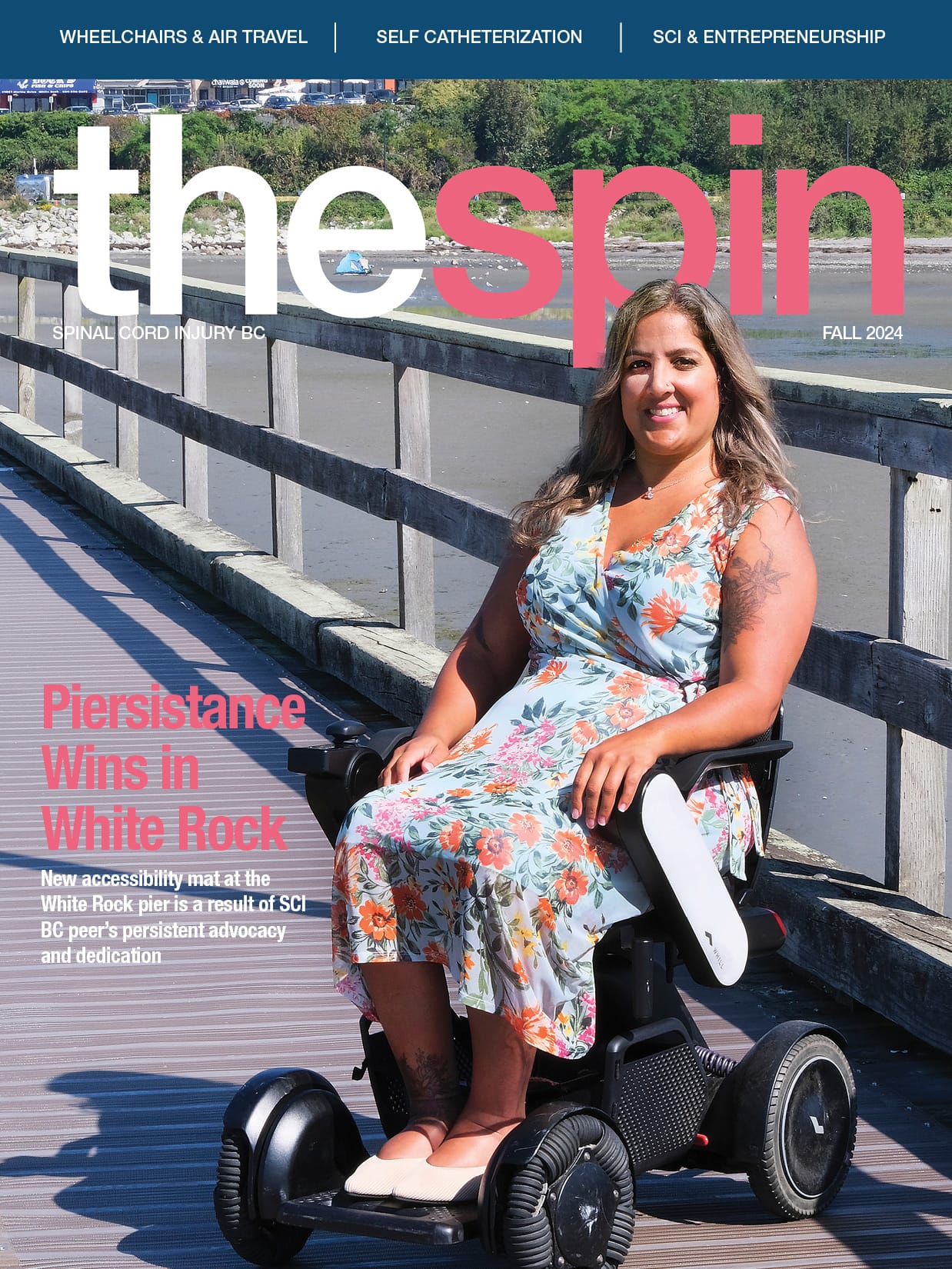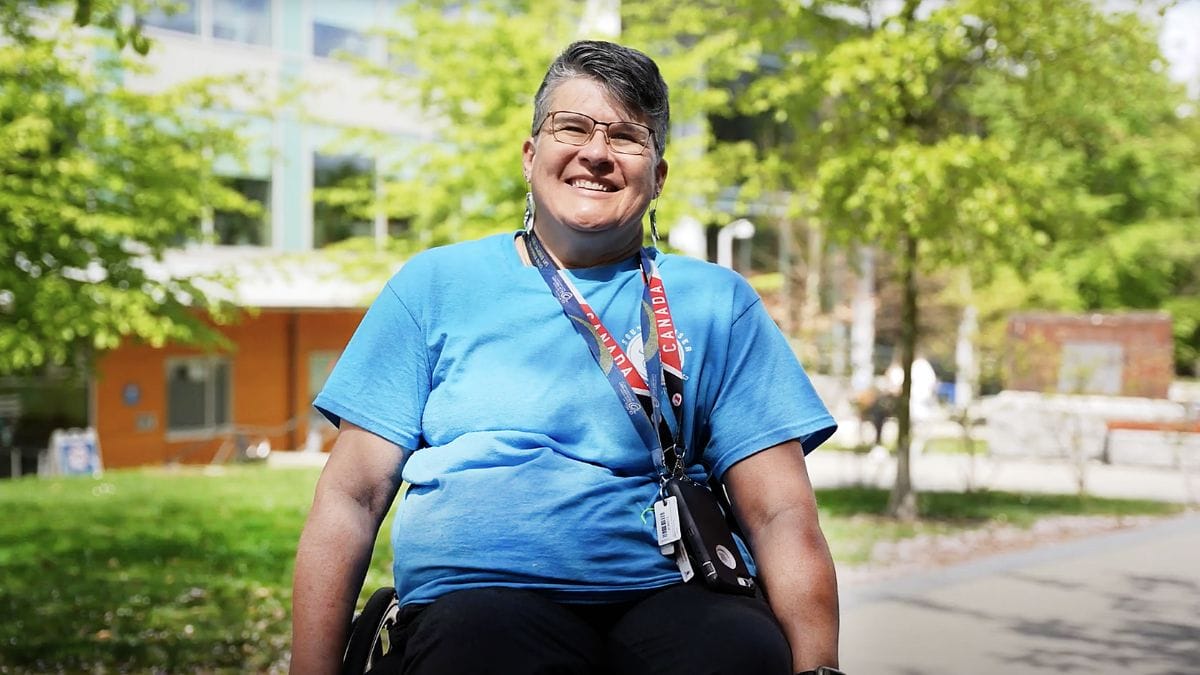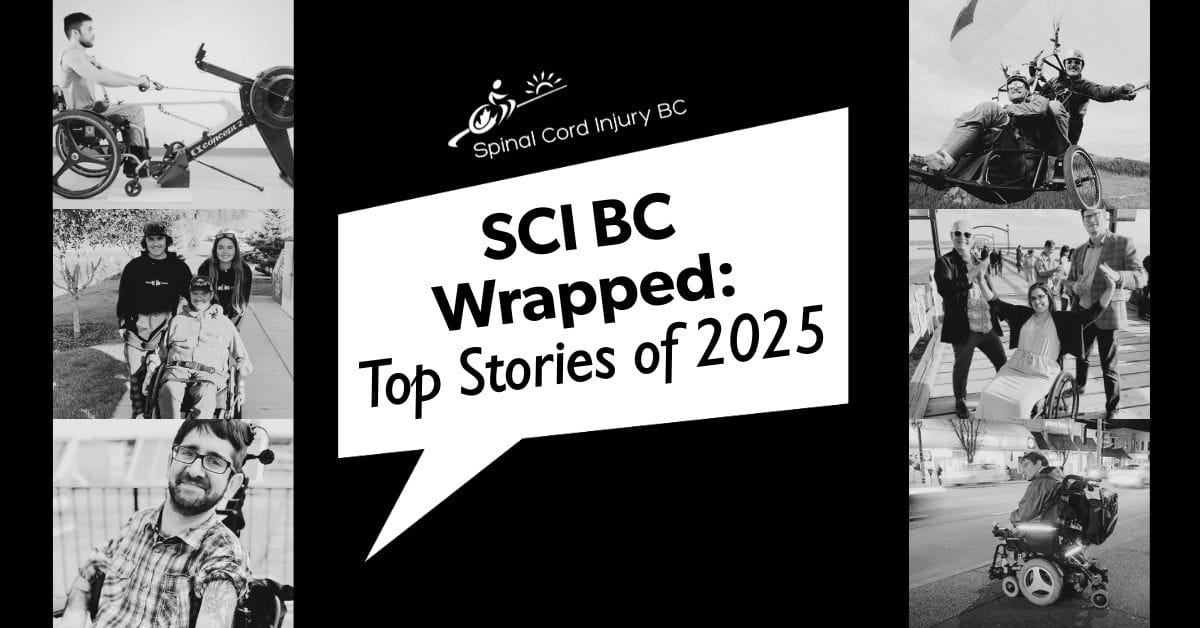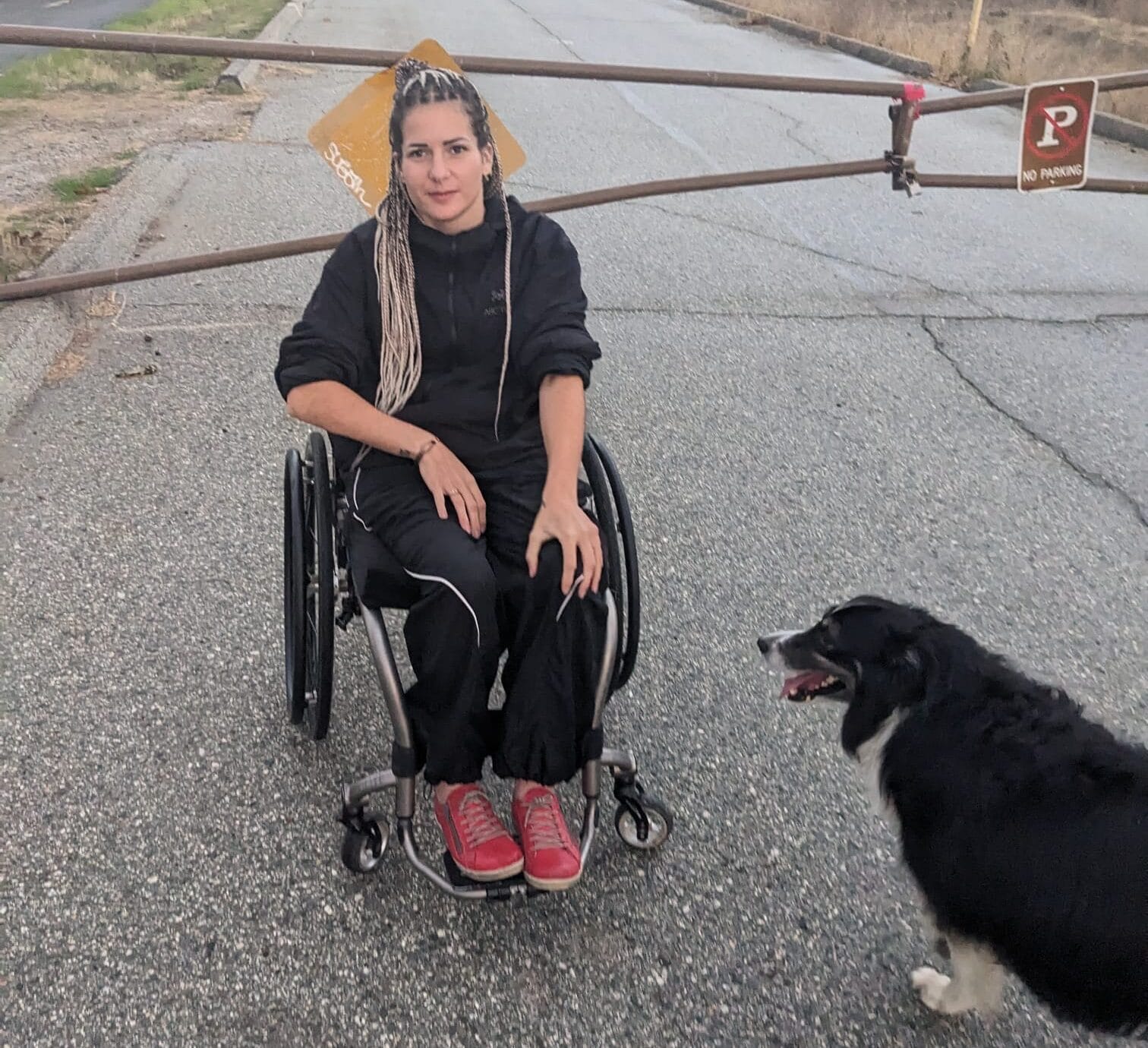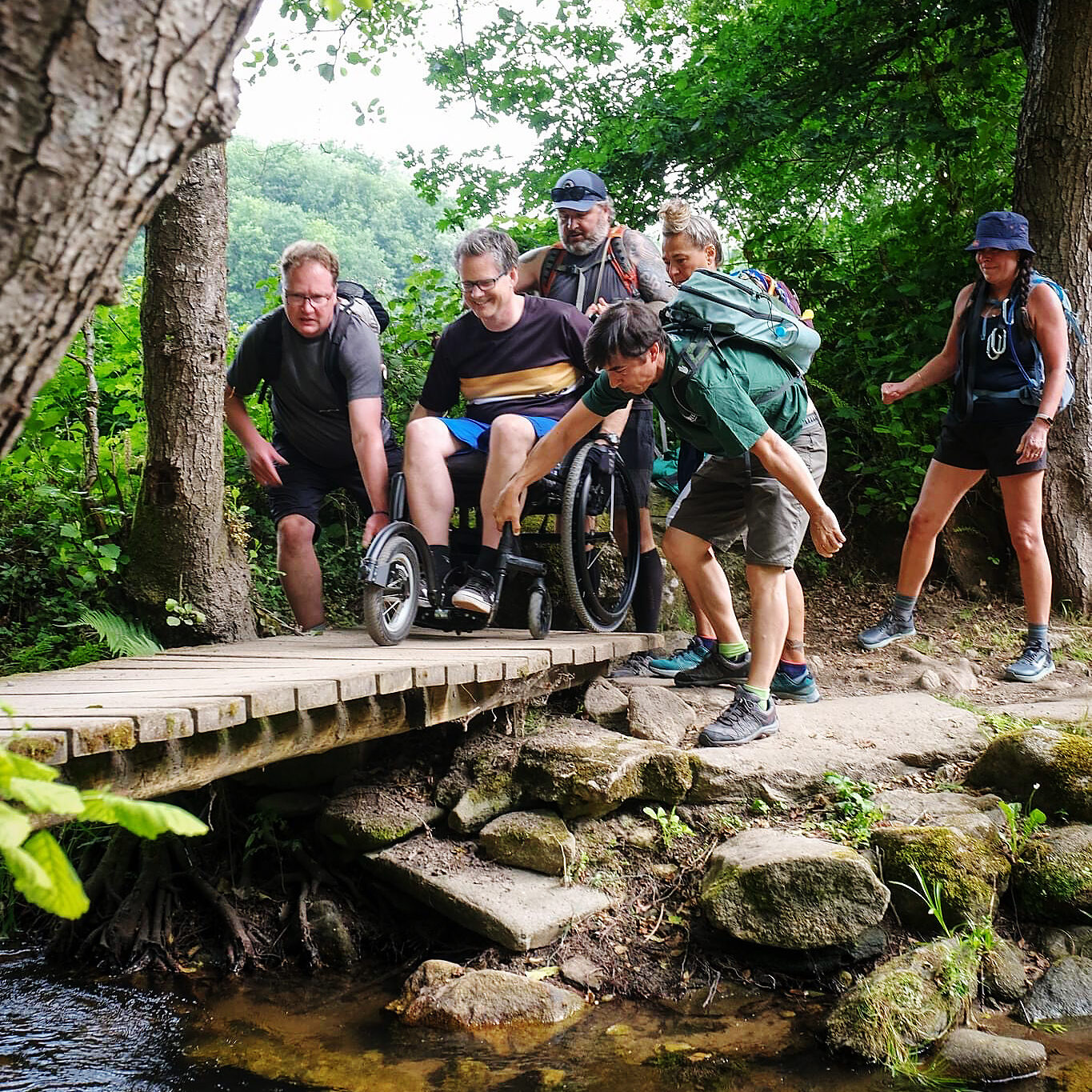
Jason Nelson and his wife, Lesley, love travelling. Their adventures together include hiking the Inca Trail to Machu Picchu, snorkeling with turtles and sea lions in the Galapagos Islands, and hiking into the Indonesian jungle to see orangutans. But after Nelson sustained a C6 incomplete SCI, the thought of travelling became more daunting, and even scary, to consider. SCI BC caught up with Nelson, who uses a wheelchair and is able to walk short distances with poles or a walker, to hear how his SCI didn’t dampen his enthusiasm for travel in his latest trip to Spain and what he learned about himself along the way. Here’s what he shared with us.
Last summer, we were ready to explore the world again but unsure of where to go and how to do it. The universe sometimes works in interesting ways—a friend loaned me a book that changed everything. I’ll Push You is about two best friends, embarking on the Camino de Santiago, across northern Spain. One friend pushing the other in an off-road wheelchair, along the full 800 km. After that journey, the authors Justin Skeesuck and Patrick Gray established a Camino tour for wheelchair users.
Lesley was excited about this opportunity, so we applied for the 2024 excursion and got accepted! Woohoo! We’re going to travel 114 km in six days, over rocky trails, cobblestone pathways, and over many hills and obstacles. This was exactly what we were searching for and I had a combined sense of excitement and nervousness. I used to love the adventure of landing in a new country, finding suitable accommodation, and stumbling over a foreign language. Was I ready to do this again? This time I’d have extra equipment (wheelchair, walking poles, etc.), and likely face many physical obstacles, such as stairs, curbs, uneven pathways, to name a few. And that was before we tackled 114 km of uneven ground on the Camino. Thankfully, Lesley’s sister, Michele, decided to join us on this crazy adventure.
The tour included an online training module to help us physically prepare for this task over the next seven months. The module included equipment recommendations and after a conversation with Justin, I decided to take my existing wheelchair and purchase off-road tires, a freewheel (to attach to my footplate to lift the caster wheels), straps to pull my wheelchair, and longer push canes for my helpers. Let the training begin.
Those seven months flew by, and suddenly we were boarding our first plane from Comox, BC. After 20 hours of travel and limited sleep, we were finally in Madrid. We had a couple days to recharge, before taking a train to Santiago de Compostela, to meet up with our tour group. Our group was made up of 50 people, which included seven wheelchair users, one person with a visual impairment, four guides, two videographers and a lot of helpers. Members of the group were from Brazil, Australia, France, Canada, and the US. These people would be our companions for the next eight days and in a short time, we would become close friends.
We loaded onto two buses, one with a lift for wheelchair users and one regular bus. Our destination was Lugo, which would be our home base for the first four nights while we travelled the Camino. Each day the buses would take us to our Camino start point, then back to the hotel after hiking the planned distance. The next morning they would take us to where we finished the previous day. Upon arrival in Lugo, we explored the ancient Roman wall that completely circles the old town area. It was somewhat surreal being on this ancient wall that once protected the town and was now surrounded by a wall of modern buildings.
The first evening we had our welcome dinner hosted by Patrick and Justin. We met the full group and received some important details about our upcoming journey. Each day we’d be walking and rolling approximately 20 km and we were encouraged to join a different group over the next six days to get the most out of this experience. After dinner we received a scallop shell to attach to our daypacks (customary for the Camino), a Camino passport to collect stamps from vendors (minimum two per day), and our group shirts to wear on our final day. On the passport you had to indicate the method you were using for the Camino: walking, biking, horse, or wheelchair. I was amazed and impressed that they actually had a wheelchair choice! Time to get a good night sleep before our adventure begins.
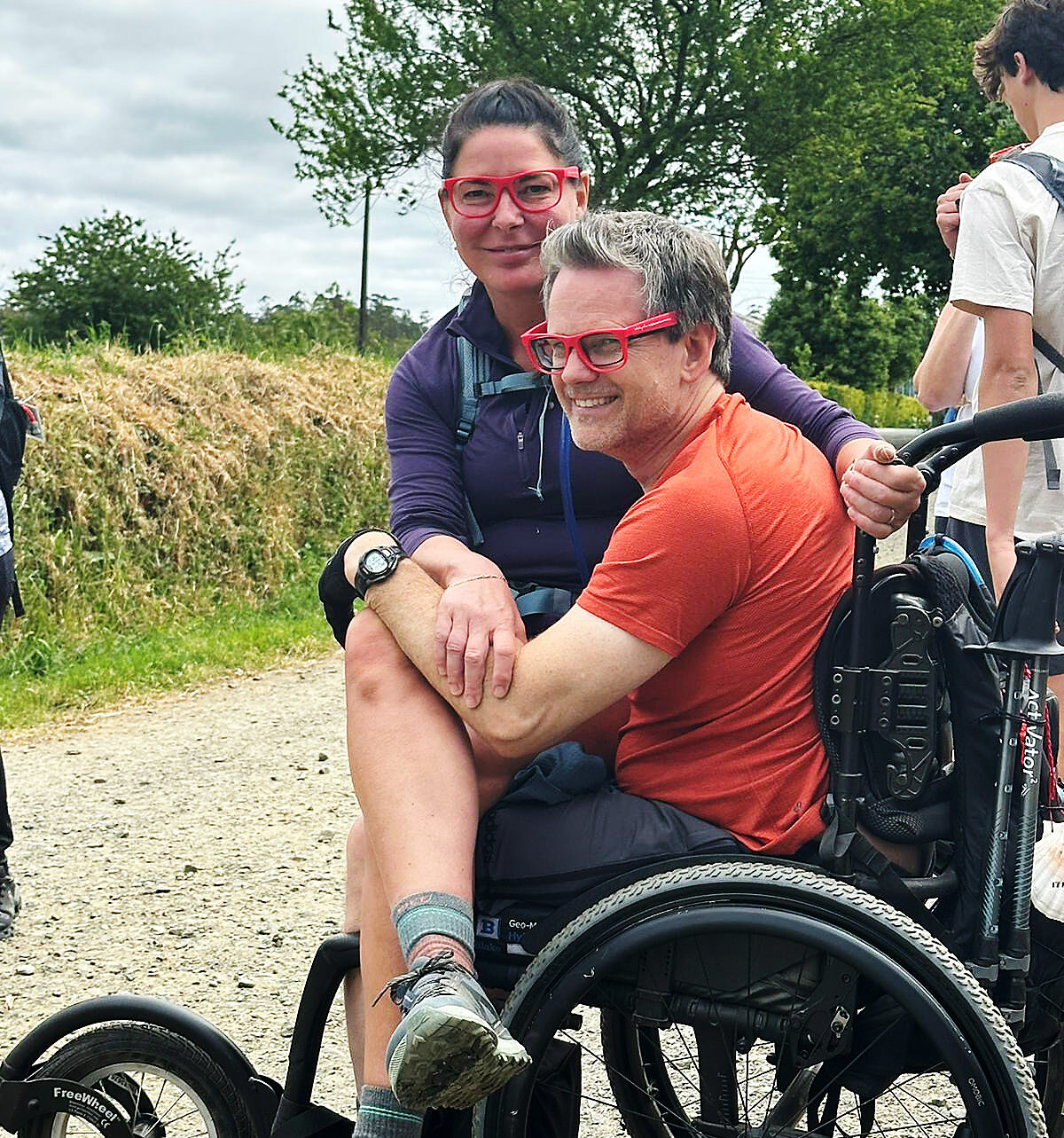
Day 1: Sarria to Portomarin
After a group photo, our abilities were immediately tested as we travelled down a very long, steep “paved” slope—I was really leaning back in my wheelchair, to offset the steepness. As we got to the base of the slope, we encountered our next obstacle, a narrow wooden bridge just wide enough for a wheelchair, and with some rock steps to get onto it. Now it became evident why we needed so many helpers. Four people hoisted me in my chair onto the 20 foot bridge. On the other side, we had a long, steep dirt slope to walk up. Time to get out our straps, attach them to the front of my wheelchair, and have the helpers begin pulling from the front and pushing from the back. Wow! This is just the beginning of six days! We finally got to a relatively flat section, where I grabbed my poles and walked a short distance.
One of my personal Camino goals was to walk a section each day. It wasn’t long before each wheelchair group was spread out along the trail. Lesley, Michele, and I were now on our own, as we encountered a long, steep slope covered with small, loose rock. We had to stop every 20 feet to catch our breath and determine our next pathway. Halfway up the slope a tractor drove down towards us. Just what we needed! There was just enough room to hug the shoulder as he slowly went past us. After what seemed like an eternity, we arrived at the designated restaurant for lunch. At this point I was tired, hungry, frustrated, and angry that we didn’t have more help over that difficult section.
As I waited for my lunch, I reflected on our recent experience, and wondered what we could have done differently. I realized there were four people a short distance behind us and we could have stopped to wait for them to catch up. With their help, that nasty terrain would have been much easier. It seems the Camino was already teaching me the value of accepting help from others, and even looking for help when faced with obstacles. With this newfound knowledge, I wouldn’t make the same mistake twice. The first day was long, and we were thoroughly exhausted. After a quick group dinner at a nearby restaurant, we headed to bed.
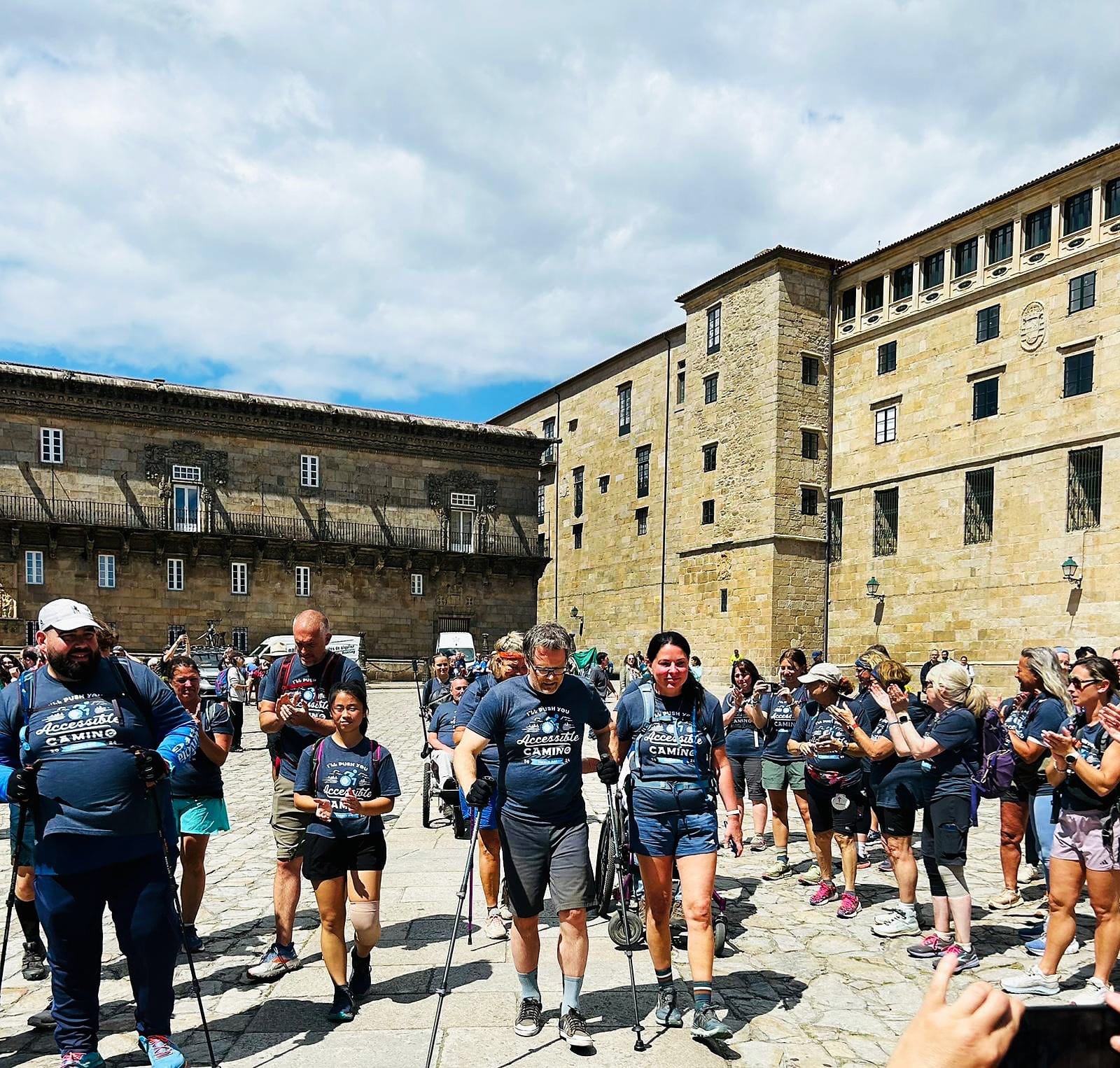
Day 2: Portomarin to Palas de Rei
The weather forecast called for rain, so I wore my waterproof pants and had a rain jacket in my daypack. Thankfully we didn’t get any rain, and the temperature was perfect for hiking. We started through the winding streets of Portomarin, over cobblestone, slate, and pavement. Today we enlisted a few additional helpers. Yesterday we learned how much you can accomplish when you have help from others. It was already feeling easier than the first day. We travelled approximately 26 km, and a large portion was paved with fewer obstacles to avoid. I even got to wheel down some paved slopes on my own. Exhausted from another long day, we ate a group dinner at the hotel, and then off to bed.
Day 3: Palas de Rei to Melide
Our first obstacle was near the beginning of our trek through Palas de Rei. It was a steep roadway of large slate rock. By now our wheelie popping skills were proficient, so we made our way down the slope. Today we had a shorter distance to walk and roll, and we’d finish a bit earlier to give us time to pack our belongings. After our hike tomorrow, we’d transfer to a hotel in Santiago for the next four nights. Lesley joined another team, and we spent the next three days in different groups while on the trail. It was good for both of us. Lesley had the opportunity to allow others to help me and it gave me the experience of receiving help from others. We travelled through a lot of small forests, mostly trails that consisted of dirt and rocks, and constantly up and down slopes. The wheelchair straps were a useful tool, helping us pull the wheelchair up long, steep slopes, and flipping it to the back of the chair to slow our descent down slopes. We had a late lunch at the end of our hike, to give us more time to pack. Even though the day was shorter, we were still tired.

Day 4: Melide to Arzua
Around 10:30 AM we came to a large obstacle. There was a creek, 25 feet wide. We could either go through the water, or onto a narrow rock bridge (slightly wider than a wheelchair). Without hesitating, I asked my team which option was the best for them. I was putting my safety in the hands of people who I had just met five days ago, and I fully trusted their decision. They decided to carry me over the water, which was a success. Our whole group cheered on each team as they navigated this latest challenge. The rest of the day consisted of rocky dirt trails and constantly travelling up or down slopes. We started to feel more conditioned to this type of activity. At the end of the day, we headed to a hotel in Santiago, our new home base for the next four nights.
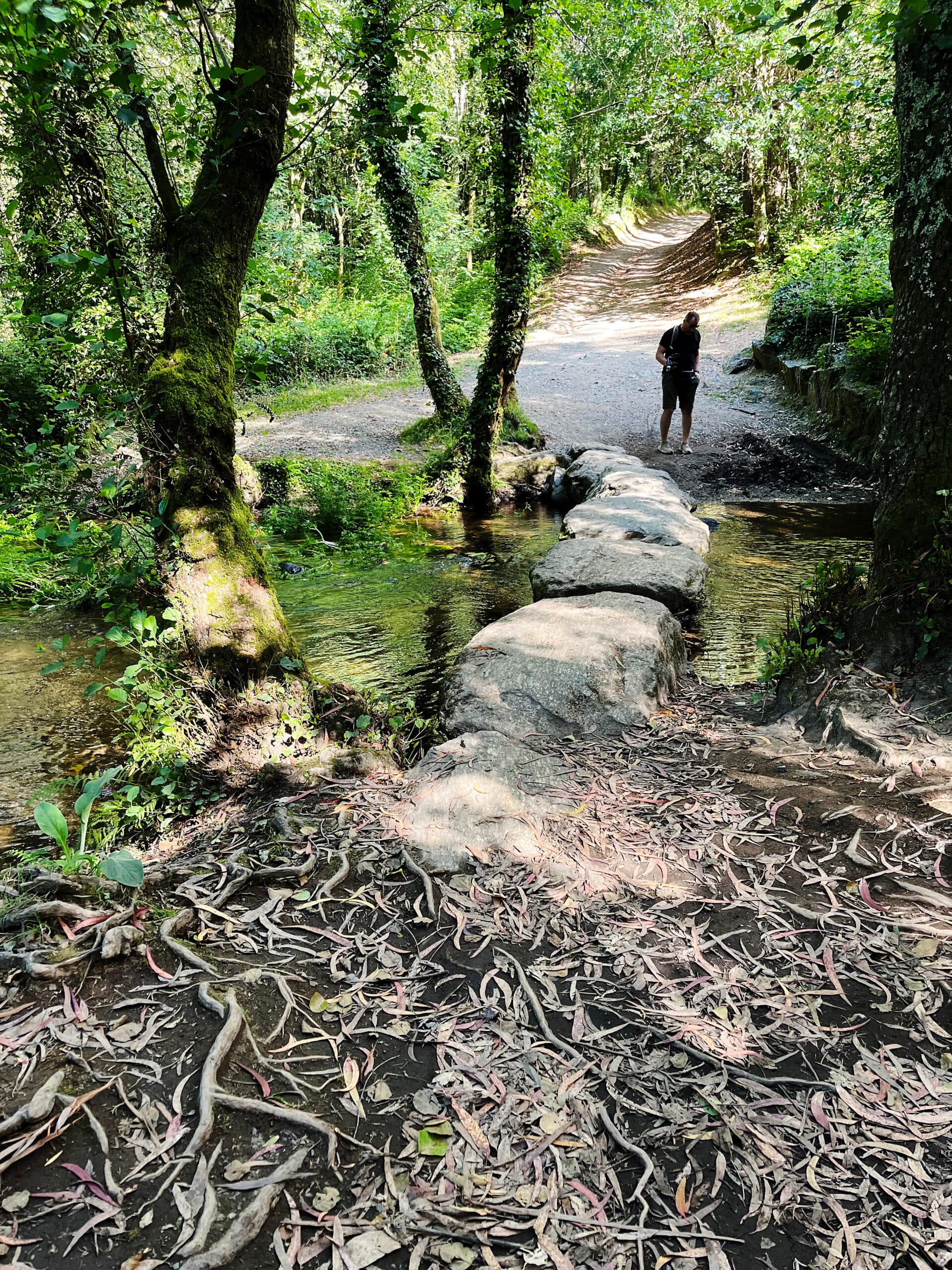
Day 5: Arzua to A Rua
Our day began with two members sharing a story about The Red Glasses Movement. Their relative, Audrey, was only five years old when she passed away in 2018. She was born with Down’s syndrome and a heart defect. Audrey was defined by her bright red glasses, her contagious smile, and her lack of inhibitions. She loved indiscriminately and without restrictions. The Red Glasses Movement is Audrey’s living legacy. Their mission is to inspire the world to live boldly, love big, and pass it on. We each received a pair of red glasses to wear on this day, to help us see through Audrey’s eyes. It was definitely an emotional start to our morning. I’m honoured to hear about Audrey’s story and I’ll do my best to live boldly and love big.
While waiting at one of our rest stops, one of the group members taught me how to wheelie. In the past I’ve spent so much time improving my walking, that I haven’t focused on wheelchair skills like wheelies. My instructor, Robert, had me in a wheelie within 15 minutes. It’s amazing how quickly a new skill can be learned when you receive good instruction. I’ll need more practice before attempting some of Robert’s crazy routes. After going through the streets of Arzua, we enter the countryside, passing through many forests, and once again travelling up or down slopes. After another long day of travel, we head to a nearby restaurant for a group dinner and then bedtime.
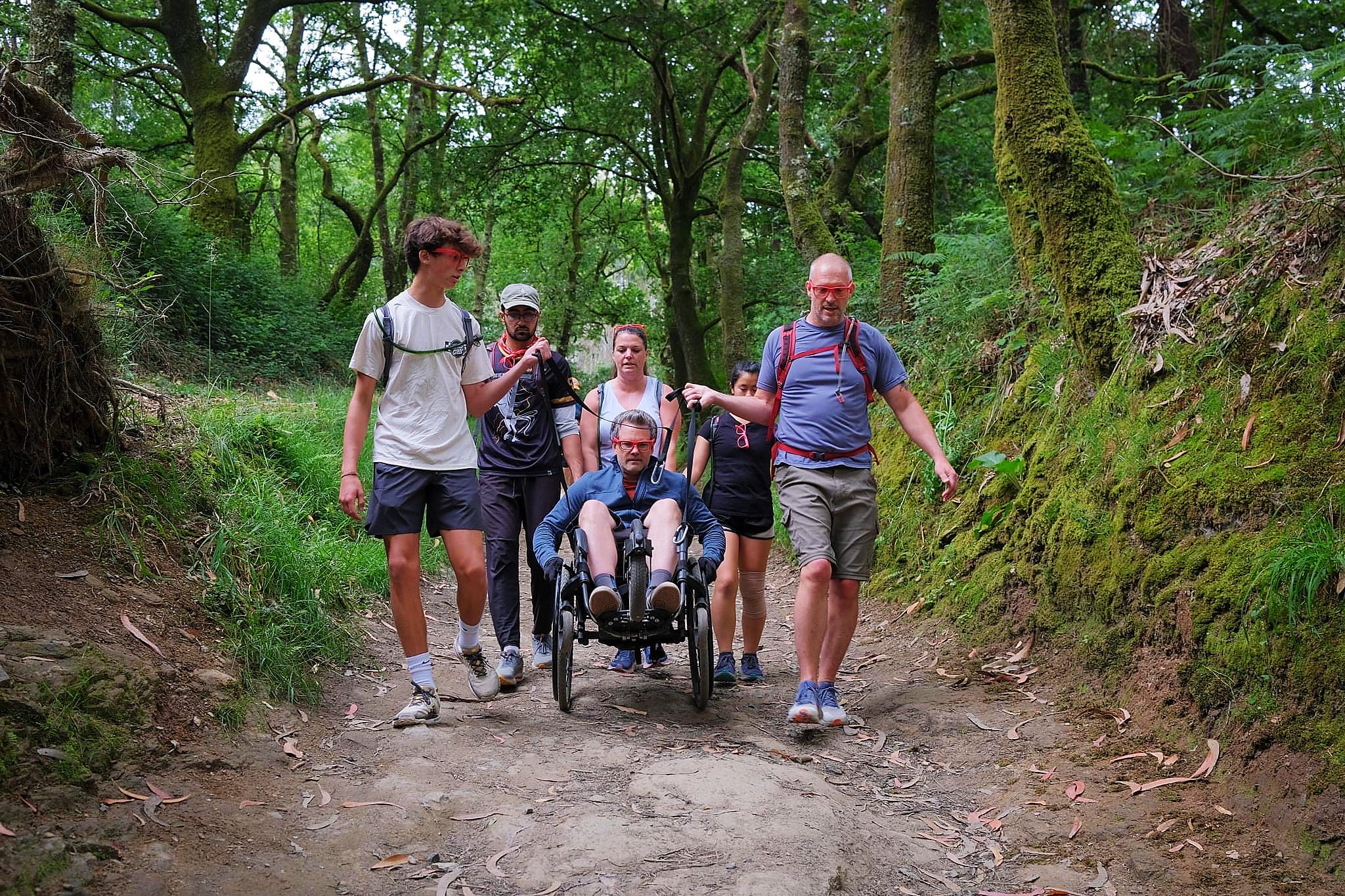
Day 6: A Rua to Santiago
Our final day on the Camino had arrived. I felt some sadness knowing that we would soon reach our goal and that this adventure would be over. Throughout the past six days, we became a tight knit family. We quickly passed through the streets of A Rua and entered the forests. We’d conquered so many obstacles that the terrain didn’t phase us. I’m proud of accomplishing my goal to walk a section of the Camino each day. Initially I was worried about the prospect of walking, when the trail seemed to always be on a steep slope.
Passing through some eucalyptus forests, we encountered a person playing bagpipes for us pilgrims. The music provided some extra energy for today. After our lunch break, we stopped at a viewpoint of Santiago de Compostela, and we saw the cathedral, our final destination. Our guides collected our passports to hand in, so that we can receive a Compostela Certificate for completing the last 100 km of the Camino. By 3 PM we reached the outskirts of Santiago, and gradually made our way through the streets to the cathedral. We entered the old town, and our whole group collected together just outside the cathedral square. Three of us wheelchair users decided to walk into the square, and our group carried on at our pace. As we got close to the square, the sound of bagpipes could be heard from the cathedral and as we entered the square, it erupted with the sounds of cheering and clapping for our group. Such an amazing experience! I can still feel that magical moment.
The next day we had our final group dinner at the Parador, a luxurious restaurant in the cathedral square. After some amazing food, we received our Compostela Certificates, with our names written in Latin. We had time to share our experiences or learnings from the past seven days and it was a very emotional night, filled with laughter and tears. It was bittersweet spending those last moments with our Camino family and I’m grateful for the time spent with these amazing people. I didn’t want it to end but I knew we had forged some lifelong friendships. Buen Camino! (That’s Spanish for Happy Trails!)
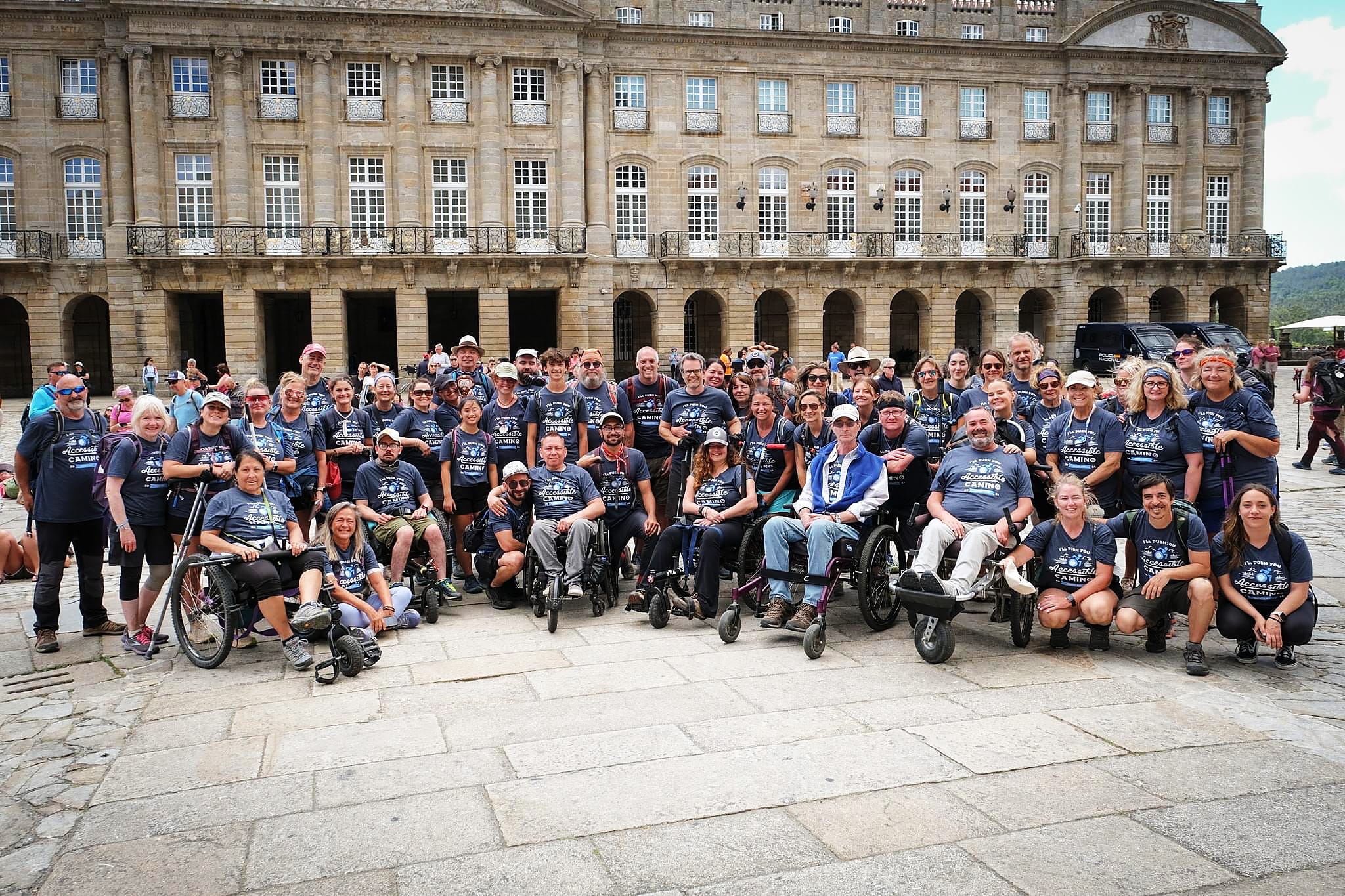
Final Thoughts
The greatest lesson that I learned was the value of accepting help from others and expanding my support network beyond my wife, Lesley. Previously, I thought accepting help meant I was a burden to others. Now I realize that most people want to help and when they provide it, they receive a fulfilling sense of purpose. When you work as a team, you can accomplish great things—I just travelled 114 km of the Camino using a wheelchair! Armed with this experience, Lesley and I are ready to travel again. Look out world, here we come.
Captivated by Nelson’s sense of adventure? Get the confidence you need for your next trip with accessible travel tips, extra peer travel stories, and more at sci-bc.ca/travel. To learn more about I’ll Push You and the Camino de Santiago, visit illpushyou.com.
This article was originally published in the Fall 2024 issue of The Spin. Read more stories from this issue, including:
- Peer advocacy
- Air travel
- Entrepreneurship
And more!
Read the full Fall 2024 Issue of The Spin online!
